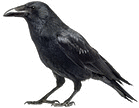

 Most of us know that feathers are good insulators. As a kid, you might have had a feather-down coat or blanket, or your grandmother may have had a comforter quilt that would keep you incredibly warm on a cold winter night. That was especially important in homes heated with wood or coal where the fire would go out around midnight and the house would get very cold.
Most of us know that feathers are good insulators. As a kid, you might have had a feather-down coat or blanket, or your grandmother may have had a comforter quilt that would keep you incredibly warm on a cold winter night. That was especially important in homes heated with wood or coal where the fire would go out around midnight and the house would get very cold.
That same insulating ability of feathers that keeps birds warm in the winter can be a liability in the summer. When the temperature hits 110 degrees, how do birds keep cool? In some cases like crows or blackbirds, the color of the bird also causes heat issues. The black feathers absorb a high percentage of the sun's rays and getting overheated can be fatal.
Like a lot of things we see in nature, the cooling features designed into birds are complex and involve several options. Birds do not sweat, but they have bare skin on their legs and faces which radiates heat. Birds increase their respiration rate in heat, producing the panting most of us have seen birds do. This action releases large amounts of heat and is similar to what we see in dogs. Most species of birds have a blood control device that increases the blood flow to their beaks in hot weather, causing rapid heat loss.
In addition to these physical design features, there are behavioral ways that birds keep cool. Wing flutters and the lifting of feathers increase air circulation, pulling heat from the bird's body. Some birds use evaporative cooling by bathing or urinating on their legs. Some birds soar where the air is cooler. Most birds feed in the cooler parts of the day and seek shade and rest during the hottest times of the day. The sound of moving water attracts many species of birds, and they will fly through a mist, a waterfall, or rub against wet foliage.
The Bible tells us “we can know there is a God through the things he has made” (Romans 1:18 – 20). Observing how the design of God's creatures allows survival in the hottest and coldest of times is one evidence of design. Source: National Wildlife, August/September 2014, page 12.
Picture credits:
© Life on White. Image from BigStockPhoto.com.
